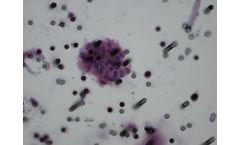Applications
-
Premium
Laboratory instruments solutions for petrochemical and biofuel
Crude oil is a highly complex mixture of hydrocarbons. Through desalting, distillation, and conversion, it is transformed into fractions of higher-quality hydrocarbons such as paraffins, aromatics, naphthenes, and olefins. Different ratios of these so-called PIANO compounds are blended to yield different fuel and lubricant types. Increasingly, fossil fuels are blended with biofuels. Both blending and refining processes are demanding and require precise and reliable analysis. Regardless whether you deal with fossil ...
By Metrohm AG based in Herisau, SWITZERLAND.
-
Premium
Hyperbaric Oxygen Therapy for Sports
Hyperbaric Oxygen Therapy (HBOT) for professional sports has become one of the most effective methods for athlete ...
By OXYHELP INDUSTRY Srl based in Bucuresti, ROMANIA.
-
Premium
Track-Etched Polymer Membrane Filters for Diagnostics
Recovery of cervical cancer cells and isolation of circulating rare cells, detection and counting of bacteria recovered from food, beverage or cosmetics (flow cytometry, fluorescence microscopy), detection and analysis of recovered airborne particles (asbestos, AOX), ...
By it4ip S.A. based in Louvain-la-Neuve, BELGIUM.
-
Premium
Oil Water Separators for Chemicals, Plastics and Rubber
Suspended and/or Settleable Solids Removal. Process ...
By Hydro Quip, Inc. (HQI) based in Seekonk, MASSACHUSETTS (USA).
-
Premium
Ultrasound measurement instrumentation solutions for physiotherapy sector
Employing ultrasound to improve blood circulation is an established technique, particularly in sports medicine to treat muscle and ligament injuries. Unlike diagnostic ultrasound imaging, the total acoustic power is sufficient to cause a low level of tissue heating making it vital to accurately control the acoustic ...
By Onda Corporation based in Sunnyvale, CALIFORNIA (USA).
-
Premium
Environment Chambers for Pharmaceutical Industry
Stability, Photostability, Cold ...
By Aralab based in Albarraque, PORTUGAL.
-
Premium
FT-NIR analysis for pharmaceutical raw material identification sector
Within the globalized pharmaceutical raw material supply chain, there is an increasing public health concern of raw material adulteration, contamination, or mislabeling, especially with recent incidents such as the adulteration of heparin. This has driven regulatory bodies to update their guidelines. Chapter 5.33 of the latest GMP guidelines for Medicinal Products for Human Use, provided by the European Commission (EC), entitled "Eudralex," specifies that "there should be appropriate procedures or measures to ...
By Galaxy Scientific Inc based in Nashua, NEW HAMPSHIRE (USA).
-
Premium
Heat Exchangers Solutions for Solvent Sector
Solvent recovery requires a robust heat exchanger which can cope with this important process step. The economic and environmental implications of not getting solvent recovery right can be disastrous. Solvent discharge to the environment is a challenge for many companies, but the right heat exchange solution integrated into a suitable bespoke recovery system will remove pollutants from extraction gases, contaminated air or even ...
By HRS Heat Exchangers Ltd. based in Watford, UNITED KINGDOM.
-
Premium
Hyperbaric Oxygen Therapy for Bauty and Relaxation
Embracing the use of HBOT to favor aesthetic objectives is a relatively new approach to an ever-growing complementary treatment, oxygen ...
By OXYHELP INDUSTRY Srl based in Bucuresti, ROMANIA.
-
Premium
Temperature and gas sensing solutions products for medical applications
Shorten product development, increase reliability, and benefit from compliance expertise. Increased lifestyle conditions, patient lifespans, and outpatient procedures are transforming medical equipment. Equipment needs to be more mobile, include data storage and insight capabilities, and be more precise than ...
By Advanced Energy Industries, Inc. based in Denver, COLORADO (USA).
-
Premium
Quality assurance of pharmaceuticals
With regard to the quality and safety of drugs, authorities worldwide set high standards for the pharmaceutical industry. To ensure these high quality and safety standards, reliable instruments and methods are needed. ...
By Metrohm AG based in Herisau, SWITZERLAND.
-
Premium
Industrial equipment solutions for special mobility areas
Industrial equipment solutions for special mobility ...
By Koller Maschinen- und Anlagenbau GmbH based in Celle, GERMANY.
-
Premium
Mixing and Grinding Technology for Lead Acid Paste
The unique EVACTHERM process, developed by Eirich, proves all over the world its outstanding position in the very environment-friendly and economical manufacture of lead acid ...
By Maschinenfabrik Gustav Eirich GmbH & Co KG based in Hardheim, GERMANY.
-
Premium
Thermoformed plastic solutions for thermoplastic molding industry
For over 40 years, Brentwood’s passion has been helping customers turn ideas into reality through innovative thermoforming and injection molding services. With many forming capabilities and diverse materials expertise, Brentwood is able to create targeted, tailored solutions for each project. Custom thermoformed and injection molded solutions from an industry leader with the expertise and resources to handle large-scale, complex projects from concept through ...
By Brentwood Industries, Inc. based in Reading, PENNSYLVANIA (USA).
-
Premium
Industrial filtrations solutions for petrochemical industry
Oil Sludge. Tank Bottoms. Fuel Clarification. Refinery Oil Slurries. Completion ...
By D. R. Sperry & Company based in Aurora, ILLINOIS (USA).
-
Premium
Environment Chambers for Medical Plants Industry
Seed Storage, Mother Plant, Propagation, Vegetative Growth, Flowering, Drying, Storage, Gmp ...
By Aralab based in Albarraque, PORTUGAL.
-
Premium
Chemiluminescense based analyzer for medical industry
Exhaled Nitric Oxide (FeNO) measurements are easy to perform and may be used to monitor eosinophilic airway inflammation (Asthma). A range of computerized pulmonary diagnostic products ranging from neonatology to adult pulmonary function testing are manufactured by ECO PHYSICS AG. These products are marketed and distributed by the label ECO ...
By ECO Physics AG based in Duernten, SWITZERLAND.
-
Premium
Parallel evaporation for the pharmaceutical industry
For quality control in pharmaceutical industry and in the development of new components ...
By BUCHI based in Flawil, SWITZERLAND.
-
Premium
Determnation of albumin concentration in urine
INTRODUCTION The capillary electrophoresis method provides det ermination of albumin concentration in ...
By Lumex Instruments based in Mission, BRITISH COLUMBIA (CANADA).
-
Premium
Thermoformed plastic solutions for medical industry
By providing the medical industry with innovative design services and cutting-edge manufacturing processes, Brentwood is able to produce thermoformed packaging and injection molded components that increase efficiency and reduce costs. Quality packaging and components for manufacturers that demand precision, innovation, and reliability from a full-service ...
By Brentwood Industries, Inc. based in Reading, PENNSYLVANIA (USA).
Need help finding the right suppliers? Try XPRT Sourcing. Let the XPRTs do the work for you
















